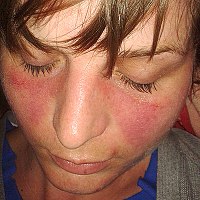
Photo from wikipedia
Background: Systemic sclerosis (SSc) is characterized by immune system alterations, vascular damage and fibrosis (1). Macrophages seem to have an emerging role in SSc, and the characterization of their polarized… Click to show full abstract
Background: Systemic sclerosis (SSc) is characterized by immune system alterations, vascular damage and fibrosis (1). Macrophages seem to have an emerging role in SSc, and the characterization of their polarized phenotype, starting from the dichotomic definition of classically activated (M1) or alternatively activated (M2) macrophages, is a recent research topic of interest (2). Objectives: The study investigated a possible imbalance in the distribution of circulating cells expressing M1 and M2 markers in SSc patients (pts) compared to healthy subjects (HSs), and the presence of circulating cells co-expressing M1 and M2 surface markers. Possible correlations between their percentage and selected SSc clinical aspects were investigated. Methods: In the study 55 SSc pts (50 females/5 males, mean age 64±13 yrs), fulfilling the new EULAR/ACR criteria for SSc diagnosis, and 27 age-matched HSs (25 females/2 males, mean age 57±7 yrs) were enrolled after written informed consent. Nailfold videocapillaroscopy (NVC), evaluation of SSc-related antibodies and pulmonary functional tests were performed. In particular, circulating cells belonging to the leukocyte and monocyte populations (CD45+and CD14+cells) were investigated by flow cytometry (FC) using the surface markers characterizing M1 (CD80, CD86, TLR2, TLR4) and M2 phenotypes (CD204, CD206, CD163). Statistical analysis was performed using Mann-Whitney and Kruskal-Wallis tests, and correlations were explored by bivariate Pearson’s analysis. Results: Increased circulating cells showing an M2 phenotype and characterized as CD204+CD206+CD163+cells was observed in SSc pts compared to HSs (p<0.0001), whereas no difference in CD80+CD86+TLR2+TLR4+(M1) cell percentage was observed. A significant higher percentage of circulating cells showing a hybrid M1/M2 phenotype (CD204+CD206+CD163+TLR4+CD80+CD86+cells) was observed in SSc pts compared to HSs. These hybrid M1/M2 cells were significantly increased in SSc pts either treated with steroids or under no immunosuppressive treatment (p<0.01; p<0.05), as well as in Scl70+pts (p<0.05 vs. Scl70-pts) and SSc pts with interstitial lung disease (ILD) and high systolic pulmonary artery pressure (PAP). A linear negative correlation between the high hybrid M1/M2 cell percentage and diffusing capacity of the lungs for carbon monoxide (DLCO)% and the forced vital capacity (FVC)/DLCO ratio higher than 1.5 was observed. No significant correlations were reported with SSc duration, other treatments, NVC patterns, renal artery resistive index, heart and kidney involvements, digital ulcers, telangiectasias, calcinosis. Conclusion: The study identified a circulating cell population expressing both M1 and M2 surface markers, which is increased together with circulating M2 cells in SSc pts, in particular affected by ILD and high PAP, suggesting their possible involvement in the pathogenesis of those disease complications. Further evaluations are in progress. References: [1] Cutolo M, et al. Nat Rev Rheumatol. 2015;11:569-71. 2. Stifano G, et al. Curr Rheumatol Rep. 2016;18:2. Disclosure of Interests: None declared
Journal Title: Annals of the Rheumatic Diseases
Year Published: 2019
Link to full text (if available)
Share on Social Media: Sign Up to like & get
recommendations!